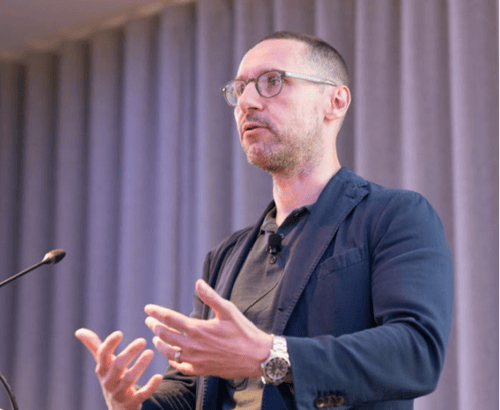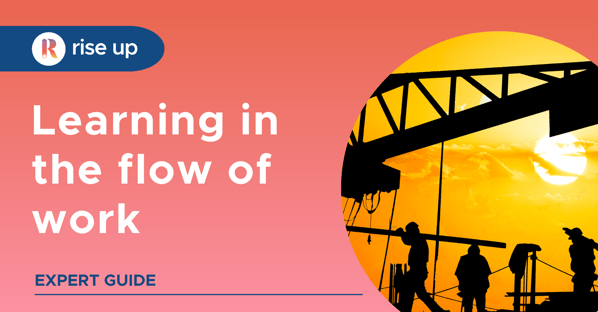8 Minutes of reading
The secrets to Learning in the Flow of Work: Key Insights from LPI Learning Live

The Learning and Performance Institute's (LPI) Learning Live event brought together learning experts from all over the UK.
At the forefront of these discussions was the theme of "Learning in the Flow of Work," which emerged as the #1 challenge according to LPI insights from the learning professional survey, announced by Edmond Monk as he kicked off the event.
In this summary blog, we will highlight key takeaways and quotes from the event's speakers and presentations, shedding light on the importance of integrating learning seamlessly into the work environment and how to best achieve it.
Learning for the Long Term - Rosemary Hoskins, AstraZeneca
Rosemary Hoskins, Global Capability Leader for Learning Strategy Skills at AstraZeneca, emphasized the need for a learning content strategy that is not just about providing more content but focuses on long-term skills development. She stressed the importance of learning content being applicable, high quality, discoverable, and measurable. Learning content standards, such as defining the audience, setting clear behavioral objectives, and measuring success, are crucial in ensuring that learning leads to real-world impact.
Hoskins also highlighted the shift towards self-led learning, which has been more effective than traditional workshops. A key point of discussion was the impact questionnaire that followed any learning path, which revealed that 97% of learners believed they could apply their learning in their work. AstraZeneca's LIFOW approach centered on enabling individuals to learn for life and fostering application at work rather than merely measuring attendance rates or subjective satisfaction.
Building an Organizational Learning Culture - Dell Technologies, Senior Sales L&D Team
Jan Lindborg and Billy Benn from Dell Technologies discussed their journey in creating a culture of continuous learning. With 133,000 employees, Dell's focus on harnessing the power of human curiosity and technology has been instrumental in transforming its learning culture. Jan and Billy emphasized the importance of making learning experiences real for employees and understanding that they are taken away from their job every time they undergo training.
Dell's approach included leveraging technology to provide point-of-need data and context-led content to employees. They also highlighted the significance of podcasts, learning playlists, virtual chats, and AI-based recommendations to integrate learning seamlessly into the work environment.
To help them with their LIFOW plans, they create a persona for their learner, Linda in Sales. They kept bringing the focus back to Linda, where she was, and what she would need. Their aim was to ensure she had access to the knowledge she needed at any given point, whether it be via salesforce during pipeline hygiene or whilst waiting for a prospect in a car park and sending Linda, the prospect’s LinkedIn to brush up on her knowledge on her target customer.
The key takeaway was reminding the audience:
“Technology can help you achieve your strategy, technology is not the strategy, learning in the flow of work is. Focus first on people, and process and tech will fall into place when it comes to LIFOW.”
Need help with embedding LIFOW into your learning strategy? Book a free consultant workshop to review and advise on your current learning processes here.
Embedding Learning into the Flow of Work - Adam Lancaster, Ex Meta’s Director of L&D
Adam Lancaster, former Director of L&D at Meta, discussed the challenges faced by various organizations and the opportunities presented by Learning in the Flow of Work (LIFOW). He stressed the importance of aligning L&D goals with business goals and the need to observe how people in the company spend their time at work.
Lancaster shared a practical approach based on moments strategy, where micro-moments, current moments, and defining moments in an employee's workday are observed to create structured and deliberate learning experiences. His success metrics were aligned with business objectives, ensuring that L&D programs had a direct impact on the organization:
“You need to consider what your business does and how it goes about making it happen - this is what you need to connect against your L&D goals.”
Adam recognized the feeling of being overwhelmed with trying to implement LIFOW into the organization, and provided this advice: Focus on impact - which team really had an impact on business objectives - swarmed around the key team. Ruthlessly prioritize, consider where am I spending my time, energy and effort? I can’t get to every single learner and leader, so start with what’s most important to enable effective scalability.

His other key takeaway aligns closely with Rise Up’s mission,
“Worry about integrating not innovating! People use word, teams, zoom, excel so build stuff there.”
Like Adam we believe in meeting learners where they are, not interrupting their flow of work, merely enhancing it with relevant insights and assets. We have built bespoke deep integrations with business applications like MS Teams, and Salesforce for this exact reason. If you would like to see how these systems work, book your demo here.
To summarize, Learning in the Flow of Work emerged as a critical challenge and opportunity in the world of learning and development. The insights and strategies shared at the LPI Learning Live event underscore the importance of seamlessly integrating learning into the work environment, aligning with business objectives, and fostering a culture of continuous learning. As organizations navigate the future of work, they must prioritize the development of their employees' skills and adapt to the changing landscape to thrive in the years to come.



